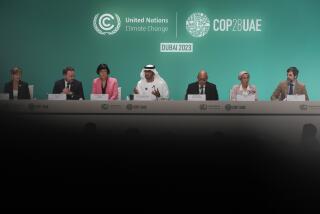Air apparent to Kyoto
The international climate negotiations that have been grinding on for years may have crossed a Rubicon of sorts. That’s because a new model of engagement for some nations is receiving wide attention. It’s shorthanded as “national schedules,” and it could get incorporated into the next world climate treaty -- the one that replaces the Kyoto Protocol -- to be signed in Copenhagen in December.
Under the proposal, nations would list the steps they promise to take to deal with climate change and the reduced emissions they expect each step to result in. The model is drawn from international trade negotiations, in which nations schedule measures taken to free up trade.
There are very important differences between agreeing to Kyoto-type terms and agreeing to list actions on national schedules. Under Kyoto, developed nations are obliged to account for all of their greenhouse gas emissions and to reduce them to a pre-agreed cap by a certain year. Under a national schedules approach, however, countries select a subset of emissions sources to act on and fix, but they do not agree to account for and cap all of their national emissions.
The increased national autonomy this provides, and the simplified accounting resulting from having to deal with a self-chosen subset of emissions, is very attractive to some countries. But the downside is the lack of an overall emissions cap -- and therefore the potential for greenhouse emissions to continue to grow.
Still, adding a national schedules option to the global climate treaty makes sense, especially because it could spur climate-saving action in developing nations, which have so far been given a pass by the Kyoto Protocol. India and China, for example, two hefty polluters, are not obliged to account for and cap their emissions. However, getting them to schedule specific actions to reduce some of their emissions could put them on track toward a total cap, not to mention contributing to lower emissions in the meantime.
It’s tempting to believe that the proposed mechanism of national schedules may have played a role in the breakthrough announcement by India’s environment minister, Jairam Ramesh, on Sept. 18 that India would accept some sort of limits on its carbon emissions. And it also may have influenced Chinese President Hu Jintao’s announcement on Sept. 22 that his country would mandate a “notable decrease” in carbon intensity by 2020. These surprising developments from the world’s largest developing economies, which have long declined to engage meaningfully in climate negotiations, have had the effect of revitalizing the negotiations.
While national schedules could play a crucial role in reengaging developing countries in the climate negotiations, they raise many difficulties. One of the most immediate is their effect on carbon trading -- the buying and selling of emission allowances meant to put a (high) price on greenhouse gases. The Kyoto Protocol, with its accounting of total national emissions, provides a clear mechanism for carbon trading. There’s no obvious way for countries on national schedules to participate, so the overall market is likely to shrink. This is bad because it would lower the price of polluting, just the opposite of what is needed for clean-technology innovation.
There is, however, a much more serious problem with national schedules. If the model were to apply to the U.S., it would represent a major step backward in controlling greenhouse gases. The U.S. remains the biggest per capita carbon emitter in the world and the only developed nation to have sidestepped Kyoto (Congress never ratified the treaty). It has made no commitment to a national emissions cap. Nor has it had the political will to pass legislation aimed at setting up a national carbon trading system. If the U.S. is allowed to adopt a national schedule instead of finally agreeing to a national cap, it would almost certainly lead to the failure of Australia and Canada to abide by their agreements to cap emissions. And that in turn would leave the Europeans all but isolated in their adherence to national emissions caps, and the developed world without an overall greenhouse gas target.
Most of the major energy generators and many of the largest polluters in the U.S. -- such as Alcoa and Duke Energy -- now favor a cap-and-trade bill. The opposition is coming primarily from chambers of commerce, principally in the Midwest, whose members fear rising energy prices.
If the United States is to lead at Copenhagen, it desperately needs to pass cap-and-trade. The reinvigorated global negotiations have only increased the pressure -- it’s time for the United States to bring something concrete to the table in December.
More to Read
Sign up for Essential California
The most important California stories and recommendations in your inbox every morning.
You may occasionally receive promotional content from the Los Angeles Times.










